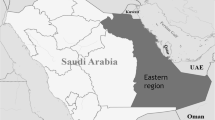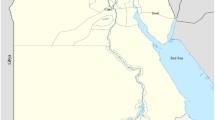Abstract
Coxiella burnetii, or Q fever agent, has notable implications for human and livestock health. Infections in cattle primarily manifest through reproductive issues where infected animals shed the bacterium in birth fluids, placental tissues, and milk, serving as potential sources of transmission. Bovine herds become reservoirs, contributing to the environmental contamination of farming areas. Comprehensive studies on the prevalence, transmission routes, and associated risk factors among cattle contribute to the development of effective control strategies, ultimately safeguarding both livestock and public health.Here we determine the prevalence of Coxiella burnetii antibodies against in dairy cattle farms from Kabylia (northern Algeria) and identify the associated risk factors. Bulk tank milk samples from 184 farms were analyzed by indirect ELISA technique, 49 of them were tested positive which corresponds to a prevalence rate of 26.63% (95% CI 20.25–33.01%). Multivariate analysis by logistic regression showed that the risk factors associated with detection of anti-Coxiella burnetii antibodies are: cohabitation of cattle with small ruminants(OR = 3.74 95% CI [1.41–8.92]), exposure to prevailing winds (OR = 5.12 95% CI [2.11–13.45]), and the veterinarian visits frequency(OR = 5.67 95% CI [2.55–13.60]). These findings underscore the susceptibility of dairy cattle to Q fever in the Kabylia region, highlighting practices that pose risks. We recommend the implementation of hygienic measures and adherence to proper farming conditions to mitigate the transmission of Q fever and reduce the associated zoonotic risk.

Similar content being viewed by others
Data availability
The datasets generated and/or analyzed in this study are not publicly available for administrative reasons( pending thesis defense), but can be obtained from the corresponding author upon reasonable request.
References
Abdelhadi, F.Z., Abdelhadi, S.A., Niar, A., Benallou, B., Meliani, S., Smail, N.L., Mahmoud, D., 2015. Abortions in Cattle on the Level of Tiaret Area (Algeria). Global Veterinaria, 14, 638–645.
Agag, S., Kaidi, R., Khelef, D., 2016. Séroprévalence de la fièvre Q chez les bovins de la région de Bejaïa (Algérie). Revue d’élevage et de médecine vétérinaire des pays tropicaux, 69, 155–159.
Agerholm, J.S., 2013. Coxiella burnetii associated reproductive disorders in domestic animals-a critical review. Acta Veterinaria Scandinavica, 55, 13.
Agger, J.F., Christoffersen, A.-B., Rattenborg, E., Nielsen, J., Agerholm, J.S., 2010. Prevalence of Coxiella burnetii antibodies in Danish dairy herds. Acta Veterinaria Scandinavica, 52, 5.
Alsaleh, A., Pellerin, J.-L., Rodolakis, A., Larrat, M., Cochonneau, D., Bruyas, J.-F., Fieni, F., 2011. Detection of Coxiella burnetii, the agent of Q fever, in oviducts and uterine flushing media and in genital tract tissues of the non pregnant goat. Comparative Immunology, Microbiology and Infectious Diseases, 34, 355–360.
Anastácio, S., Carolino, N., Sidi-Boumedine, K., Da Silva, G.J., 2016. Q fever dairy herd status determination based on serological and molecular analysis of bulk tank milk. Transboundary and Emerging Diseases, 63, e293–e300.
Astobiza, I., Ruiz-Fons, F., Pinero, A., Barandika, J.F., Hurtado, A., Garcia-Perez, A.L., 2012. Estimation of Coxiella burnetii prevalence in dairy cattle in intensive systems by serological and molecular analyses of bulk-tank milk samples. Journal of Dairy Science, 95, 1632–1638.
Belhouari, A., Souames, S., Berrama, Z., Ouchene, N., 2022. Seroprevalence of Q fever among ewes and associated risk factors in Ain Defla region, North-central Algeria. Comparative Immunology, Microbiology and Infectious Diseases, 87, 101853.
Berri, M., Souriau, A., Crosby, M., Crochet, D., Lechopier, P., Rodolakis, A., 2001. Relationships between the shedding of Coxiella burnetii, clinical signs and serological responses of 34 sheep. The Veterinary Record, 148, 502–505.
Boarbi, S., Fretin, D., Mori, M., 2016. Coxiella burnetii, agent de la fièvre Q. Canadian Journal of Microbiology, 62, 102–122.
EFSA, Panel on Animal Health and Welfare (AHAW), 2010. Scientific Opinion on Q fever. EFSA Journal, 8, 1–114. http://www.efsa.europa.eu/en/efsajournal/pub/1595. Accessed 23 Dec 2022.
Eldin, C., Mélenotte, C., Mediannikov, O., Ghigo, E., Million, M., Edouard, S., Mege, J.-L., Maurin, M., Raoult, D., 2017. From Q fever to Coxiella burnetii infection: a paradigm change. Clinical Microbiology Reviews, 30, 115–190.
España, P.P., Uranga, A., Cillóniz, C., Torres, A., 2020. Q fever (Coxiella burnetii). Seminars in respiratory and critical care medicine, 41, 509–521.
Hireche, S., Agabou, A., Bouaziz, O., 2020. Seroprevalence of Coxiella burnetii among ewes and associated risk factors in Constantine (Northeastern Algeria). Journal of the Hellenic Veterinary Medical Society, 71, 2383–2390.
Khaled, H., Sidi-Boumedine, K., Merdja, S., Dufour, P., Dahmani, A., Thiéry, R., Rousset, E., Bouyoucef, A., 2016. Serological and molecular evidence of Q fever among small ruminant flocks in Algeria. Comparative Immunology, Microbiology and Infectious Diseases, 47, 19–25.
Khalili, M., Sakhaee, E., Aflatoonian, M.R., Shahabi-Nejad, N., 2011. Herd–prevalence of Coxiella burnetii (Q fever) antibodies in dairy cattle farms based on bulk tank milk analysis. Asian Pacific Journal of Tropical Medicine, 4, 58–60.
Kruszewska, D., Tylewska-Wierzbanowska, S., 1997. Isolation of Coxiella burnetii from bull semen. Research in Veterinary Science, 62, 299–300.
Lacheheb, A., Raoult, D., 2009. Seroprevalence of Q-fever in Algeria. Clinical Microbiology and Infection, 15, 167–168.
MADR (Ministère de l’Agriculture et du Développement Rural). Statistique agricole superficies et productions SERIE « B » 2019. 2021. https://madr.gov.dz/wp-content/uploads/2022/04/SERIE-B-2019.pdf. Accessed 23 Dec 2022.
Maurin, M., Raoult, D. 1999. Q fever. Clinical Microbiology Reviews, 12, 518–553.
Menadi, S.E., Mura, A., Santucciu, C., Ghalmi, F., Hafsi, F., Masala, G., 2020. Seroprevalence and risk factors of Coxiella burnetii infection in cattle in northeast Algeria. Tropical Animal Health and Production, 52, 935–942.
Menadi, S.E., Chisu, V., Santucciu, C., Di Domenico, M., Curini, V., Masala, G., 2022. Serological, Molecular Prevalence and Genotyping of Coxiella burnetii in Dairy Cattle Herds in Northeastern Algeria. Veterinary Sciences, 9, 40.
Mori, M., Mertens, K., Cutler, S.J., Santos, A.S., 2017. Critical aspects for detection of Coxiella burnetii. Vector-Borne and Zoonotic Diseases, 17, 33–41.
Muskens, J., Van Engelen, E., Van Maanen, C., Bartels, C., Lam, T., 2011. Prevalence of Coxiella burnetii infection in Dutch dairy herds based on testing bulk tank milk and individual samples by PCR and ELISA. The Veterinary Record, 168, 79.
Nielsen, K.T., Nielsen, S.S., Agger, J.F., Christoffersen, A.-B., Agerholm, J.S., 2011. Association between antibodies to Coxiella burnetii in bulk tank milk and perinatal mortality of Danish dairy calves. Acta Veterinaria Scandinavica, 53, 64.
Nusinovici, S., Hoch, T., Brahim, M.L., Joly, A., Beaudeau, F., 2017. The Effect of Wind on Coxiella burnetii Transmission Between Cattle Herds: A Mechanistic Approach. Transboundary and Emerging Diseases, 64, 585–592.
Ohlson, A., Malmsten, J., Frössling, J., Bölske, G., Aspán, A., Dalin, A.-M., Lindberg, A., 2014. Surveys on Coxiella burnetii infections in Swedish cattle, sheep, goats and moose. Acta Veterinaria Scandinavica, 56, 39.
Paiba, G.A., Green, L.E., Lloyd, G., Patel, D., Morgan, K.L., 1999. Prevalence of antibodies to Coxiella burneti (Q fever) in bulk tank milk in England and Wales. The Veterinary Record, 144, 519–522.
Pellerin, J.L., Alsaleh, A., Mermillod, P., Souza-Fabjan, J.M.G., Rodolakis, A., Rousset, E., Dubreil, L., Bruyas, J.F., Roux, C., Fieni, F., 2018. Attachment of Coxiella burnetii to the zona pellucida of in vitro produced goat embryos. Theriogenology, 106, 259–264.
Pexara, A., Solomakos, N., Govaris, A.Q., 2018. Q fever and seroprevalence of Coxiella burnetii in domestic ruminants. Veterinaria Italiana, 54, 265–279.
Rodolakis, A., 2009. Q fever in dairy animals. Annals of the New York Academy of Sciences, 1166, 90–93.
Rousset, E., Arricau-Bouvery, N., Souriau, A., Huard, J., Rodolakis, A., Pepin, M., Aubert, M. Les modalités de transmission de la fièvre Q à l’Homme. In: Bulletin épidemiologique. Agence Française de sécurité sanitaire des aliments (AFSSA). 2003. https://be.anses.fr/sites/default/files/BEP-mg-BE7_0.pdf, accessed 23 Dec 2022.
Rousset, E., Berri, M., Durand, B., Dufour, P., Prigent, M., Delcroix, T., Touratier, A., Rodolakis, A., 2009. Coxiella burnetii shedding routes and antibody response after outbreaks of Q fever-induced abortion in dairy goat herds. Applied and Environmental Microbiology, 75, 428–433.
Ruiz-Fons, F., Astobiza, I., Barandika, J.F., Juste, R.A., Hurtado, A., Garcia-Perez, A.L., 2011. Measuring antibody levels in bulk-tank milk as an epidemiological tool to search for the status of Coxiella burnetii in dairy sheep. Epidemiology and infection, 139, 1631–1636.
Ruiz-Fons, F., González-Barrio, D., Aguilar-Ríos, F., Soler, A.J., Garde, J.J., Gortázar, C., del Rocío Fernández-Santos, M., 2014. Infectious pathogens potentially transmitted by semen of the black variety of the Manchega sheep breed: Health constraints for conservation purposes. Animal Reproduction Science, 149, 152–157.
Schimmer, B., Ter Schegget, R., Wegdam, M., Züchner, L., de Bruin, A., Schneeberger, P.M., Veenstra, T., Vellema, P., Van Der Hoek, W., 2010. The use of a geographic information system to identify a dairy goat farm as the most likely source of an urban Q-fever outbreak. BMC Infectious Diseases, 10, 69.
Sidi-Boumedine, K., Rousset, E., Henning, K., Ziller, M., Niemczuck, K., Roest, H., Thiéry, R., 2010. Development of harmonised schemes for the monitoring and reporting of Q-fever in animals in the European Union. EFSA Supporting Publications, 7, 48.
Tissot-Dupont, H., Amadei, M.-A., Nezri, M., Raoult, D., 2004. Wind in November, Q fever in December. Emerging Infectious Diseases, 10, 1264–1269.
Woldehiwet, Z., 2004. Q fever (coxiellosis): epidemiology and pathogenesis. Research in Veterinary Science, 77, 93–100.
Acknowledgements
We wish to thank Dr Bensafia Mounir, Dr Oudafal Abdelhakim, Dr Foughali Asma Amina for their valuable help in the field; the staff of the biochemistry laboratory of the Biotechnology Research Centre for their technical assistance.
Funding
The authors declare that no funds, grants, or other support were received during the preparation of this manuscript.
Author information
Authors and Affiliations
Contributions
All authors contributed to the study conception and design. Material preparation, data collection and analysis were performed by Salah Agag, Bachir Medrouh and Hamza Khaled. The first draft of the manuscript was written by Salah Agag and revised by Hamza Leulmi, Hanene Djeghim and Hacène Medkour Conceptualisation of study was performed by Rachid Kaidi, Djamel Khelef and Salah Agag. All authors commented on previous versions of the manuscript. All authors read and approved the final manuscript.
Corresponding author
Ethics declarations
Ethical statement
All animal owners declared their oral consent before the collection of the milk samples as well to the related survey questions.
Conflict of interest
The authors have no relevant financial or non-financial interests to disclose.
Additional information
Publisher’s Note
Springer Nature remains neutral with regard to jurisdictional claims in published maps and institutional affiliations.
Rights and permissions
Springer Nature or its licensor (e.g. a society or other partner) holds exclusive rights to this article under a publishing agreement with the author(s) or other rightsholder(s); author self-archiving of the accepted manuscript version of this article is solely governed by the terms of such publishing agreement and applicable law.
About this article
Cite this article
Agag, S., Medrouh, B., Khaled, H. et al. Prevalence and associated risk factors of anti-Coxiella burnetii antibodies in dairy cattle herds using bulk tank milk analysis in Kabylia area, north Algeria. Trop Anim Health Prod 56, 106 (2024). https://doi.org/10.1007/s11250-024-03950-y
Received:
Accepted:
Published:
DOI: https://doi.org/10.1007/s11250-024-03950-y




